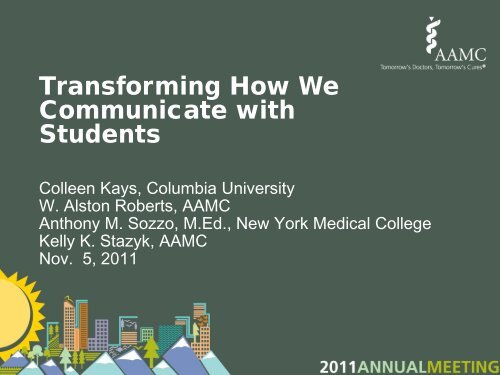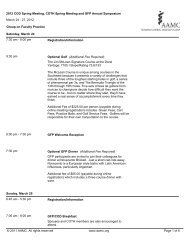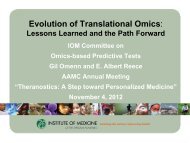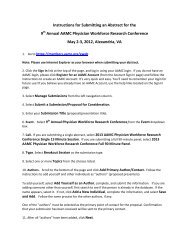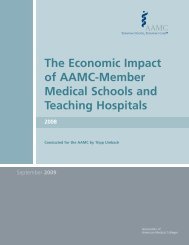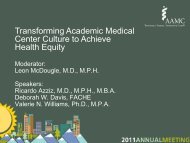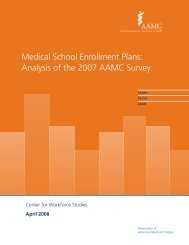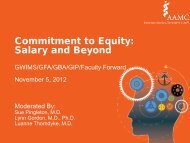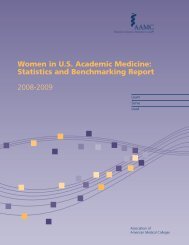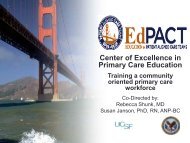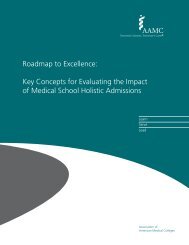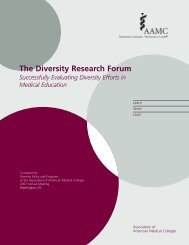Transforming How We Communicate with Students - AAMC
Transforming How We Communicate with Students - AAMC
Transforming How We Communicate with Students - AAMC
You also want an ePaper? Increase the reach of your titles
YUMPU automatically turns print PDFs into web optimized ePapers that Google loves.
<strong>Transforming</strong> <strong>How</strong> <strong>We</strong><br />
<strong>Communicate</strong> <strong>with</strong><br />
<strong>Students</strong><br />
Colleen Kays, Columbia University<br />
W. Alston Roberts, <strong>AAMC</strong><br />
Anthony M. Sozzo, M.Ed., New York Medical College<br />
Kelly K. Stazyk, <strong>AAMC</strong><br />
Nov. 5, 2011
Session goal and objectives<br />
Goal<br />
•To allow the opportunity for participants to feel more<br />
comfortable <strong>with</strong> this new way to engage <strong>with</strong> students<br />
Objectives<br />
•Participants will leave this session<br />
• understanding the capabilities of at least two tools<br />
• <strong>with</strong> three ideas about how they might use social<br />
media<br />
• <strong>with</strong> an action planning outlining next steps for<br />
implementing social media
CiM’s social media journey<br />
GSA National Spring Meeting, April 2010<br />
CiM student focus groups<br />
National survey <strong>with</strong> Penn State COM
Evolution of receiving<br />
information<br />
One-way push<br />
Engagement/2-way<br />
discussion
Social media integration
Developments in social media<br />
• Peer-2-Peer networking and sharing<br />
• Marketing & PR<br />
• B2C (CRM) and B2B relations<br />
• Private networks/social intranets, collaboration<br />
tools<br />
• Intersection of social learning and social media
Peer-2-Peer Networking
Social media as a<br />
marketing & PR tool
B2B (CRM) & B2C relations
Private Networks/Social Intranets
Social Media<br />
is technology<br />
used to<br />
connect >2<br />
people<br />
Social<br />
Learning<br />
provides<br />
collective<br />
understanding<br />
to new ideas<br />
At their<br />
intersection: <strong>How</strong><br />
they work together<br />
to support new<br />
modes of teaching<br />
and learning<br />
Image Source: Marcia Conner & Tony Bingham - The New Social Learning: <strong>Transforming</strong> Your Organizations Through Social Media
Disruptive<br />
Yet Highly Innovative Technology<br />
+ =
<strong>How</strong> to manage innovation<br />
Introduction of social media tools in the<br />
academic medicine environment
Transition to new technologies<br />
“<strong>We</strong> have received a number of<br />
inquires from member institutions<br />
and their affiliates concerning<br />
connections to the Internet, the<br />
interconnected network of<br />
networks linking academic and<br />
other organizations throughout<br />
the world. “
Important themes<br />
• Social networking is the engine of social media<br />
• Important to define social media “use” in<br />
academic medicine<br />
• Disruption is challenging, but can create new<br />
opportunities and innovative techniques for<br />
teaching and learning<br />
• Same content, new channels of delivery, new<br />
techniques and practices
Faculty/Staff perspective<br />
Reviewing the landscape: I asked myself…<br />
What changed, what’s new, and what remained<br />
the same<br />
• Core profession values<br />
• Student needs<br />
• <strong>How</strong> technological have our students become.<br />
• In essence what changed is the delivery system.
Faculty/Staff perspective<br />
Why Podcasts, Screen Capture/YouTube and<br />
Facebook Why not Twitter<br />
• Needed to ease into the new technologies<br />
• Podcasts were first and very easy to do<br />
• Screen Capture was the next iteration via<br />
YouTube<br />
• Facebook is where our students live.<br />
• I like Twitter but my students prefer Facebook
Faculty/Staff perspective<br />
Early concerns moving to social media<br />
• “Being out there”<br />
• Lack of control<br />
• “Going Viral”<br />
• Needed to create and maintain a professional<br />
presence<br />
• Would it work
Faculty/Staff perspective<br />
Concerns were eased. Why<br />
• Security and content controls abound<br />
• With podcasts, you record the message<br />
• With screen capture, you record the message<br />
and visual content<br />
• YouTube and Facebook very tight security<br />
and content controls
Faculty/Staff perspective<br />
Is it working YES!<br />
• Podcasts have been deemed favorable by the<br />
students and their parents as short, quick, and<br />
right to the point.<br />
• Timely, urgent information is sent, stopping<br />
frantic, worrisome calls<br />
• i.e., moving to Direct Loans<br />
• Screen Capture/YouTube helps visual learners<br />
• Facebook page has 670 fans <strong>with</strong> many insights<br />
per post.
Faculty/Staff perspective<br />
Future possibilities<br />
• Live or recorded webinars<br />
• Live chat
Student perspective<br />
When, how, and why I use social media<br />
• When and how<br />
• Constantly<br />
• Already have app on my phone<br />
• Why<br />
• Streamlined access to people and<br />
information
Student perspective<br />
“But I don’t want school to be in my Facebook!”<br />
<strong>Students</strong> have concerns too BUT<br />
• Interacting online doesn't have to be different<br />
than interacting in person<br />
oThe professional boundaries don't have be<br />
crossed
The value of social media<br />
• Creates engagement and direct connection to<br />
individuals and communities of practice and<br />
expertise<br />
• Immediate and real-time access to different<br />
networks of specialized interests<br />
• Allows for quickly responding and staying current<br />
• traffic conditions<br />
• evolution of profession
The value of using social media<br />
<strong>with</strong> students<br />
Social media offers<br />
• opportunities to connect and build relationships<br />
<strong>with</strong> students [engage], <strong>with</strong><br />
• the ability to resume and continue conversations<br />
more frequently and conveniently.<br />
Social media is where students are and what they<br />
want
Where students are when they<br />
enter medical school
Where students are when they<br />
graduate medical school
Action Plan exercise<br />
Please complete needs assessment before you<br />
leave—both sides!<br />
Major elements of an action plan<br />
1. specific tasks<br />
2. time horizon<br />
3. resource allocation<br />
Source:Business Dictionary, http://www.businessdictionary.com/definition/action-plan.html,<br />
accessed September 22, 2011<br />
Visit www.aamc.org/services/cim for resources.<br />
Also follow @cimadvisor on Twitter.


